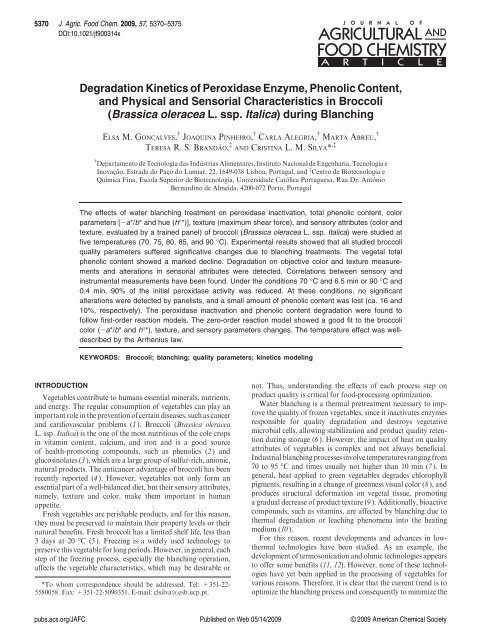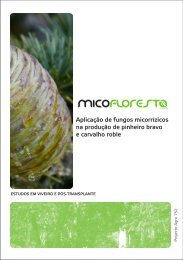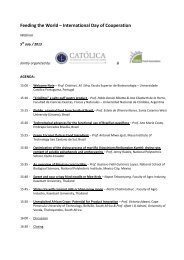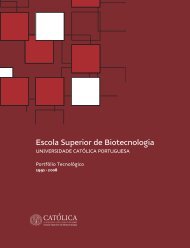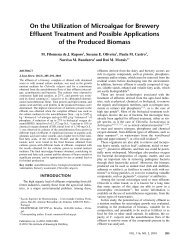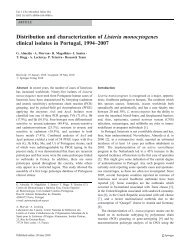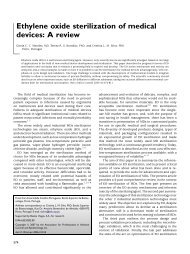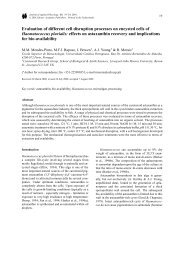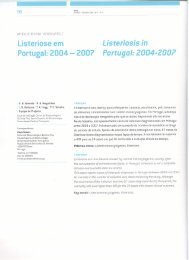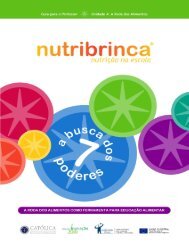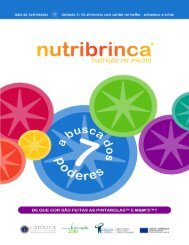Degradation Kinetics of Peroxidase Enzyme, Phenolic Content, and ...
Degradation Kinetics of Peroxidase Enzyme, Phenolic Content, and ...
Degradation Kinetics of Peroxidase Enzyme, Phenolic Content, and ...
You also want an ePaper? Increase the reach of your titles
YUMPU automatically turns print PDFs into web optimized ePapers that Google loves.
5370 J. Agric. Food Chem. 2009, 57, 5370–5375<br />
DOI:10.1021/jf900314x<br />
<strong>Degradation</strong> <strong>Kinetics</strong> <strong>of</strong> <strong>Peroxidase</strong> <strong>Enzyme</strong>, <strong>Phenolic</strong> <strong>Content</strong>,<br />
<strong>and</strong> Physical <strong>and</strong> Sensorial Characteristics in Broccoli<br />
(Brassica oleracea L. ssp. Italica) during Blanching<br />
ELSA M. GONC-ALVES, † JOAQUINA PINHEIRO, † CARLA ALEGRIA, † MARTA ABREU, †<br />
TERESA R. S. BRANDA˜ O, ‡ AND CRISTINA L. M. SILVA* ,‡<br />
† Departamento de Tecnologia das Industrias Alimentares, Instituto Nacional de Engenharia, Tecnologia e<br />
Inovac-a˜ o, Estrada do Pac-o do Lumiar, 22, 1649-038 Lisboa, Portugal, <strong>and</strong> ‡ Centro de Biotecnologia e<br />
Química Fina, Escola Superior de Biotecnologia, Universidade Catolica Portuguesa, Rua Dr. Antonio<br />
Bernardino de Almeida, 4200-072 Porto, Portugal<br />
The effects <strong>of</strong> water blanching treatment on peroxidase inactivation, total phenolic content, color<br />
parameters [-a*/b* <strong>and</strong> hue (h°*)], texture (maximum shear force), <strong>and</strong> sensory attributes (color <strong>and</strong><br />
texture, evaluated by a trained panel) <strong>of</strong> broccoli (Brassica oleracea L. ssp. Italica) were studied at<br />
five temperatures (70, 75, 80, 85, <strong>and</strong> 90 °C). Experimental results showed that all studied broccoli<br />
quality parameters suffered significative changes due to blanching treatments. The vegetal total<br />
phenolic content showed a marked decline. <strong>Degradation</strong> on objective color <strong>and</strong> texture measurements<br />
<strong>and</strong> alterations in sensorial attributes were detected. Correlations between sensory <strong>and</strong><br />
instrumental measurements have been found. Under the conditions 70 °C <strong>and</strong> 6.5 min or 90 °C <strong>and</strong><br />
0.4 min, 90% <strong>of</strong> the initial peroxidase activity was reduced. At these conditions, no significant<br />
alterations were detected by panelists, <strong>and</strong> a small amount <strong>of</strong> phenolic content was lost (ca. 16 <strong>and</strong><br />
10%, respectively). The peroxidase inactivation <strong>and</strong> phenolic content degradation were found to<br />
follow first-order reaction models. The zero-order reaction model showed a good fit to the broccoli<br />
color (-a*/b* <strong>and</strong> h°*), texture, <strong>and</strong> sensory parameters changes. The temperature effect was welldescribed<br />
by the Arrhenius law.<br />
KEYWORDS: Broccoli; blanching; quality parameters; kinetics modeling<br />
INTRODUCTION<br />
Vegetables contribute to humans essential minerals, nutrients,<br />
<strong>and</strong> energy. The regular consumption <strong>of</strong> vegetables can play an<br />
important role in the prevention <strong>of</strong> certain diseases, such as cancer<br />
<strong>and</strong> cardiovascular problems (1 ). Broccoli (Brassica oleracea<br />
L. ssp. Italica) is the one <strong>of</strong> the most nutritious <strong>of</strong> the cole crops<br />
in vitamin content, calcium, <strong>and</strong> iron <strong>and</strong> is a good source<br />
<strong>of</strong> health-promoting compounds, such as phenolics (2 ) <strong>and</strong><br />
glucosinolates (3 ), which are a large group <strong>of</strong> sulfur-rich, anionic,<br />
natural products. The anticancer advantage <strong>of</strong> broccoli has been<br />
recently reported (4 ). However, vegetables not only form an<br />
essential part <strong>of</strong> a well-balanced diet, but their sensory attributes,<br />
namely, texture <strong>and</strong> color, make them important in human<br />
appetite.<br />
Fresh vegetables are perishable products, <strong>and</strong> for this reason,<br />
they must be preserved to maintain their property levels or their<br />
natural benefits. Fresh broccoli has a limited shelf life, less than<br />
3daysat20°C (5 ). Freezing is a widely used technology to<br />
preserve this vegetable for long periods. However, in general, each<br />
step <strong>of</strong> the freezing process, especially the blanching operation,<br />
affects the vegetable characteristics, which may be desirable or<br />
*To whom correspondence should be addressed. Tel: +351-22-<br />
5580058. Fax: +351-22-5090351. E-mail: clsilva@esb.ucp.pt.<br />
not. Thus, underst<strong>and</strong>ing the effects <strong>of</strong> each process step on<br />
product quality is critical for food-processing optimization.<br />
Water blanching is a thermal pretreatment necessary to improve<br />
the quality <strong>of</strong> frozen vegetables, since it inactivates enzymes<br />
responsible for quality degradation <strong>and</strong> destroys vegetative<br />
microbial cells, allowing stabilization <strong>and</strong> product quality retention<br />
during storage (6 ). However, the impact <strong>of</strong> heat on quality<br />
attributes <strong>of</strong> vegetables is complex <strong>and</strong> not always beneficial.<br />
Industrial blanching processes involve temperatures ranging from<br />
70 to 95 °C <strong>and</strong> times usually not higher than 10 min (7 ). In<br />
general, heat applied to green vegetables degrades chlorophyll<br />
pigments, resulting in a change <strong>of</strong> greenness visual color (8 ), <strong>and</strong><br />
produces structural deformation on vegetal tissue, promoting<br />
a gradual decrease <strong>of</strong> product texture (9 ). Additionally, bioactive<br />
compounds, such as vitamins, are affected by blanching due to<br />
thermal degradation or leaching phenomena into the heating<br />
medium (10 ).<br />
For this reason, recent developments <strong>and</strong> advances in lowthermal<br />
technologies have been studied. As an example, the<br />
development <strong>of</strong> termosonication <strong>and</strong> ohmic technologies appears<br />
to <strong>of</strong>fer some benefits (11, 12). However, none <strong>of</strong> these technologies<br />
have yet been applied in the processing <strong>of</strong> vegetables for<br />
various reasons. Therefore, it is clear that the current trend is to<br />
optimize the blanching process <strong>and</strong> consequently to minimize the<br />
pubs.acs.org/JAFC Published on Web 05/14/2009 © 2009 American Chemical Society
Article J. Agric. Food Chem., Vol. 57, No. 12, 2009 5371<br />
Table 1. Published Kinetic Parameters for POD Thermal Inactivation<br />
thermal impact on vegetable quality. The optimization <strong>of</strong> the<br />
blanching processes requires not only the knowledge <strong>of</strong> the<br />
conditions that lead to enzyme inactivation but also the relationship<br />
between product quality parameters, nutritional <strong>and</strong>/or<br />
sensory, <strong>and</strong> thermal process time-temperature.<br />
<strong>Peroxidase</strong> (POD), an enzyme belonging to the oxidoreductase<br />
class, is the most thermally resistant enzyme in vegetables, <strong>and</strong> for<br />
this reason, it is usually used as a biological indicator <strong>of</strong> blanching<br />
effectiveness (13, 14). The inactivation <strong>of</strong> POD has been studied<br />
on different vegetables. Table 1 reviews recent kinetics data on<br />
POD thermal inactivation in some vegetables. The majority <strong>of</strong> the<br />
published work reports biphasic first-order degradation reaction<br />
kinetics; however, other inactivation models based on different<br />
mechanisms were also applied.<br />
<strong>Phenolic</strong> compounds have been categorized into different<br />
groups such as flavonoids, tannins, phenolic acids, <strong>and</strong><br />
coumarins (20 ) <strong>and</strong> constitute one <strong>of</strong> the most important groups<br />
<strong>of</strong> natural antioxidants, because <strong>of</strong> their diversity <strong>and</strong> extensive<br />
distribution. Data on total phenolic content <strong>of</strong> processed green<br />
vegetables are recent <strong>and</strong> very limited (21 ). Some studies reported<br />
that vegetal phenolic content is influenced by technological treatments,<br />
thus affecting their stability, biosynthesis, <strong>and</strong> degradation<br />
(22, 23). No published data on thermal phenolic degradation<br />
kinetics have been found in the literature.<br />
Color <strong>and</strong> texture are important quality attributes in determining<br />
vegetable acceptability. Several researchers have published<br />
work on modeling <strong>of</strong> thermal degradation kinetics <strong>of</strong> color <strong>and</strong><br />
texture in different vegetables (24-26). Only Weemaes et al. (27 )<br />
described the thermal degradation kinetics <strong>of</strong> green color<br />
(-a value) in broccoli juice, applying a two-step fractional conversion<br />
model. However, there is a lack <strong>of</strong> studies on thermal<br />
degradation kinetics on broccoli texture, probably due to its structural<br />
heterogeneity with consequent high difficulty <strong>of</strong> evaluation.<br />
Physical instrumental analyses are the usual methods used to<br />
assess color <strong>and</strong> texture <strong>of</strong> processed vegetables. However, sensory<br />
analysis, involving a taste panel, provides a sophisticated tool to<br />
obtain a realistic description <strong>of</strong> the product’s consumer perception.<br />
Relationships between descriptive sensory attributes or consumer<br />
preferences <strong>and</strong> instrumental evaluation should be determined in<br />
food products (28 ). Only two kinetic studies were found dealing<br />
with modeling subjective evaluation changes (29, 30). The need to<br />
have a high performance <strong>of</strong> the individual judges that constitute<br />
the taste panel may be a cause for the few studies carried out.<br />
The present study was undertaken to investigate the kinetics <strong>of</strong><br />
POD inactivation, total phenolic content, color (-a*/b*<strong>and</strong>h°*),<br />
kinetic parameters<br />
ref product temperature range (°C) k (min -1 ) Tref (°C) Ea (kJ mol -1 ) kinetic model<br />
(11) watercress 40-92.5<br />
18HLF 0.24HRF 84.6<br />
421HLF 352HRF firmness (maximum shear force), <strong>and</strong> sensory characteristics<br />
(texture <strong>and</strong> color) degradations <strong>of</strong> thermally processed broccoli<br />
(B. oleracea L.), under five blanching isothermal conditions. The<br />
aim was to model all <strong>of</strong> these quality parameters for the<br />
optimization <strong>of</strong> the blanched broccoli by immersion in hot water.<br />
MATERIALS AND METHODS<br />
Arrhenius biphasic<br />
(15) green beans 70-95 2.15 85 99.1 Arrhenius first-order<br />
(16) broccoli 50-100<br />
388acidic form<br />
189neutral form<br />
269basic form<br />
75 HLF<br />
58HRF 90HLF Arrhenius first-order<br />
(7) broccoli 70-95<br />
63.5 a<br />
2277<br />
80<br />
Arrhenius biphasic first-order<br />
a<br />
(17) carrot 35-75<br />
33.0 a<br />
2000<br />
75<br />
Arrhenius biphasic first-order<br />
a<br />
148HRF<br />
(18) pumpkin 75-95 0.3 85 86 Arrhenius first-order<br />
(19) butternut squash 60-90<br />
24.9<br />
0.07<br />
65<br />
14HLF 158HRF Arrhenius biphasic first-order (T 70°C)<br />
a Value estimated.<br />
Raw Material <strong>and</strong> Processing Conditions. Fresh broccoli<br />
(B. oleracea L. spp. Italica cv. Marathon) was obtained directly from a<br />
cultivated area in Torres Vedras, Portugal. Broccoli inflorescences were<br />
cleaned <strong>of</strong> leaves <strong>and</strong> divided into florets about 5 cm in diameter, cutting<br />
stems 2 cm below the lowest ramification. For heat treatments, samples<br />
were immersed in a thermostatic water bath ((1 °C) at five temperatures,<br />
in the range <strong>of</strong> 70-90 °C, <strong>and</strong> times, until 40 min (not in sequence); the<br />
ratio sample weight/water volume was ca. 500 g <strong>of</strong> fresh product/50 L.<br />
During the heat treatments, the temperatures <strong>of</strong> the water <strong>and</strong> samples<br />
were monitored by means <strong>of</strong> thermocouples (type T thin thermocouple,<br />
1.2 mm diameter, embedded in a stainless steel hypodermic needle, Ellab,<br />
Denmark, with an accuracy <strong>of</strong> (2 °C). After they were cooled in an ice<br />
water bath (2 min), excess <strong>of</strong> moisture was removed before any further<br />
analysis. Each experiment was replicated twice. A representative sample <strong>of</strong><br />
the whole batch <strong>of</strong> the raw material was used as a reference.<br />
POD <strong>Enzyme</strong> Assay. The POD activity was assessed spectrophotometrically,<br />
according to the method described by Bifani et al. (15 ). Raw<br />
<strong>and</strong> blanched broccoli samples (20 g each) were weighed into 100 mL <strong>of</strong><br />
1 M sodium chloride solution. The samples were homogenized with a<br />
blender at 4 °C for 2 min. The homogenate was centrifuged in polypropylene<br />
tubes at 5856g, using a Sorvall Instruments RC5C centrifuge<br />
(Dupont, Wilminton, United States), at 4 °C for 15 min. The slurry was<br />
filtered using 1.2 μm membrane filters (Whatman). The filtrate was mixed<br />
with guaiacol <strong>and</strong> H 2O 2 as substrates. The absorbance increase at 470 nm<br />
was recorded using an UV/vis, ATI Unicam spectrophotometer (Unicom<br />
Limited, Cambridge, United Kingdon). The definition used for 1 unit <strong>of</strong><br />
enzyme activity was the amount <strong>of</strong> enzyme that produced a change in<br />
absorbance <strong>of</strong> 1.0 per min per mL <strong>of</strong> extract sample, under the assay<br />
conditions. The enzymatic activity is expressed as activity units/g fresh<br />
tissue. The results <strong>of</strong> the residual activity were normalized in relation to<br />
specific activity observed in the raw product. The analyses were carried out<br />
in duplicate. The initial enzyme activity was determined from five samples<br />
<strong>of</strong> fresh product.<br />
Total <strong>Phenolic</strong> <strong>Content</strong> Assay. Raw <strong>and</strong> processed vegetable<br />
samples (duplicates) were homogenized with 70% ethanol (1:1, w/v),<br />
using a Yellow line DI 25 basic polytron (IKA-Labortechnik, Stauten,<br />
Germany). The amount <strong>of</strong> total phenolic content was determined using<br />
Folin-Ciocalteu reagent, as described by Singleton et al. (31 ). After<br />
centrifugation (43140g 20 min 4 °C, Sorvall RC-5, rotor SS34), the<br />
mixture was placed in a water bath (45 °C for 15 min), <strong>and</strong> the absorbance<br />
was measured at 765 nm in the ATI Unicam spectrophotometer, using
5372 J. Agric. Food Chem., Vol. 57, No. 12, 2009 Gonc-alves et al.<br />
gallic acid as the st<strong>and</strong>ard. Results were expressed as milligram gallic acid<br />
equivalents (mGAE) per 100 g fw. Six measurements per sample were<br />
obtained.<br />
Color Evaluation. For the color determinations, 30 g <strong>of</strong> broccoli<br />
was triturated <strong>and</strong> analyzed using a tristimulus colorimeter (Colorgard<br />
System/05 Gardner port size). The colorimeter was calibrated against<br />
st<strong>and</strong>ard white <strong>and</strong> black tiles. Measurements were performed in the CIE<br />
L*a*b* system, using an illuminate C. The lightness value, L*, indicates<br />
how dark/light the sample is (varying from 0, black, to 100, white), a*isa<br />
measure <strong>of</strong> greenness/redness (varying from -60 to +60), <strong>and</strong> b* isthe<br />
grade <strong>of</strong> blueness/yellowness (also varying from -60 to +60). To describe<br />
the color behavior <strong>of</strong> broccoli during blanching treatments, the ratio <strong>of</strong><br />
(-a*/b*) <strong>and</strong> the hue angle, h°* (0-360°) (obtained by tan -1 b*/a*,<br />
expressing the characteristic/dominant color), were used. Data were<br />
obtained from 30 measurements on each sample.<br />
Texture Evaluation. Texture was determined by a shearing test<br />
performed with a Kramer cell (st<strong>and</strong>ard cell with 10 blades), using<br />
a TA.HDi. texture analyzer (Stable Micro-System Ltd., Godalming,<br />
United Kingdom). Thirty grams <strong>of</strong> broccoli pieces was placed r<strong>and</strong>omly<br />
in the base <strong>of</strong> the cell, <strong>and</strong> the maximum shear force (N) values were<br />
recorded <strong>and</strong> used as indicators <strong>of</strong> textural parameter. The test speed was<br />
8mms -1 , <strong>and</strong> the full-scale load was 500 N. Texture measurements were<br />
determined on the basis <strong>of</strong> 12 replications for each time-temperature<br />
combination.<br />
Sensorial Assessment. For sensory evaluation, a quantitative<br />
descriptive analysis was used according to Van Loey et al. (30 ). Ten<br />
trained panelists, who met the basic requirements <strong>of</strong> sensory sensitivity<br />
according to ISO 8586-1 (32 ) in adequate conditions conforming to ISO<br />
13299 (33 ), identified <strong>and</strong> discriminated color <strong>and</strong> texture sensory<br />
attributes <strong>of</strong> blanched broccoli.<br />
Two descriptors were employed to grade the quality in terms <strong>of</strong> color<br />
<strong>and</strong> texture, using a 10 cm unstructured scale, labeled from 1.0 to 9.0,<br />
corresponding to very good <strong>and</strong> very poor, respectively. Samples ((20 g)<br />
<strong>of</strong> broccoli were served in plastic dinner plates coded with three r<strong>and</strong>om<br />
digits <strong>and</strong> served in r<strong>and</strong>omized order. The panelists were asked to mark<br />
the perceived intensity <strong>of</strong> the attribute by drawing a vertical line on the<br />
scale <strong>and</strong> writing the code. During each session, the assessor had to analyze<br />
five processed samples in color <strong>and</strong> texture quality attributes at the same<br />
temperature <strong>and</strong> different times. A duplicate was given at each session just<br />
to check the panel performance, <strong>and</strong> the data arising from this duplicate<br />
sample were not used for the final analysis. The duplication <strong>of</strong> sample was<br />
also r<strong>and</strong>omized for each panelist. It was found that there was no<br />
significant difference among the duplicates, indicating good panel consistency<br />
(P e 0.05). From the length on the scale where the intensity <strong>of</strong><br />
the attributes was marked, the intensity scores were tabulated. The mean<br />
scores for intensity were calculated.<br />
Data Analysis. An analysis <strong>of</strong> variance (two-way ANOVA) was<br />
performed to determine significant effects on experimental data due to<br />
blanching time-temperature conditions. Reaction rate constants <strong>of</strong><br />
broccoli POD inactivation; phenolic content, color (-a*/b* <strong>and</strong>h°*),<br />
<strong>and</strong> texture (maximum force) changes; <strong>and</strong> sensorial analysis were<br />
estimated by nonlinear regression analysis, fitting zero- or first-order<br />
kinetic models, eqs 1 <strong>and</strong> 2 (depending on the parameter considered), to<br />
isothermal experimental data.<br />
P ¼ P0 -kTt ð1Þ<br />
P<br />
P0<br />
-kT t<br />
¼ e<br />
In the previous equations, P is the evaluated parameter, the subindex 0<br />
indicates the initial value, t is the heating time, <strong>and</strong> k is the rate constant at<br />
temperature T.<br />
The temperature effect on rate constants was described by the<br />
Arrhenius law (eq 3):<br />
k ¼ kref exp - Ea<br />
R<br />
1 1<br />
-<br />
T Tref<br />
where k is the reaction rate constant, k ref is the reaction rate constant at a<br />
finite reference temperature (T ref), E a is the activation energy, R is the<br />
ð2Þ<br />
ð3Þ<br />
Figure 1. Broccoli POD inactivation during the blanching process. The<br />
inset depicts the initial phase <strong>of</strong> inactivation.<br />
universal gas constant, <strong>and</strong> T is the absolute temperature. The reference<br />
temperature used was the average value <strong>of</strong> the range considered (i.e.,<br />
T ref =80°C), aiming at improving parameters estimation.<br />
The k 80 °C <strong>and</strong> the activation energy were estimated directly from<br />
experimental data in one step (quality factor vs time, at all temperatures),<br />
by performing a global nonlinear regression analysis, merging the<br />
Arrhenius equation <strong>and</strong> the kinetic model considered (34, 35).<br />
The parameters’ precision was evaluated by confidence intervals at<br />
95%, <strong>and</strong> the quality <strong>of</strong> the regression was assessed by the coefficient <strong>of</strong><br />
determination (R 2 ) <strong>and</strong> r<strong>and</strong>omness <strong>and</strong> normality <strong>of</strong> residuals (36 ), thus<br />
allowing best fit model parameters. Statistica version 8.0 s<strong>of</strong>tware (37 )was<br />
used for all regression analysis procedures (using least-squares estimation<br />
<strong>and</strong> Levenverg--Marquart method, for minimizing the sum <strong>of</strong> squares <strong>of</strong><br />
the deviations between the experimental values <strong>and</strong> the ones predicted by<br />
the mathematical model).<br />
RESULTS AND DISCUSSION<br />
Thermal Inactivation <strong>of</strong> POD. The average specific activity <strong>of</strong><br />
the enzyme in raw broccoli was 688.5 ( 73.8 U/g. The enzyme<br />
activity was significantly affected by the heat treatment intensity.<br />
Similar results were obtained by Murcia et al. (38 ), Muft :: ugil (39 ),<br />
<strong>and</strong> Brevwer et al. (40 ). Figure 1 shows the residual enzyme<br />
activity as a function <strong>of</strong> heating time. The values were normalized<br />
in relation to the specific activity observed in the raw product<br />
(i.e., P/P0). The POD inactivation in broccoli has been reported to<br />
follow a first-order model or biphasic first-order model (7, 16).<br />
Experimental results obtained in this work were also satisfactorily<br />
described by an Arrhenius first-order kinetic model (model fit<br />
obtained by one-step regression analysis is also included in<br />
Figure 1). The quality <strong>of</strong> the model fit was assessed by analyses<br />
<strong>of</strong> the residuals (i.e., normality <strong>and</strong> r<strong>and</strong>omness were confirmed).<br />
The value <strong>of</strong> R 2 was 0.98. Estimated kinetic parameters <strong>and</strong><br />
confidence intervals at 95% are in Table 2. The estimated Ea value<br />
is higher as compared with the value found for broccoli by<br />
Morales-Blancas et al. (7 ). Differences could be due to cultivars<br />
or measurement method. Published data on POD kinetic values<br />
have shown a wide variation (Table 1), depending on the<br />
vegetable <strong>and</strong> enzyme distribution on product <strong>and</strong> different<br />
isoenzymes considered (16 ). For optimum quality retention <strong>of</strong><br />
vegetables during frozen storage, a reduction <strong>of</strong> 90% <strong>of</strong> the initial<br />
POD activity, after the blanching process (41 ), is recommended.<br />
In the case <strong>of</strong> blanched broccoli at 70, 75, 80, 85, <strong>and</strong> 90 °C, this<br />
target reduction was obtained, respectively, after ca. 6.5, 2.7, 1.2,<br />
0.7, <strong>and</strong> 0.4 min <strong>of</strong> the thermal treatment. The rapid POD activity<br />
losses during these blanching treatments, especially at 90 °C<strong>and</strong><br />
0.4 min, may be due to the small size <strong>of</strong> the pieces involved.<br />
Normally, to promote less damage to the vegetables quality, a<br />
high-temperature-short time (HTST) treatment is recommend.
Article J. Agric. Food Chem., Vol. 57, No. 12, 2009 5373<br />
Table 2. Kinetic Parameters, <strong>and</strong> Corresponding Confidence Intervals at 95%, <strong>of</strong> Broccoli POD Inactivation <strong>and</strong> Quality Parameters Deterioration Due to Thermal<br />
Treatment<br />
However, some studies have revealed that residual, or reactive,<br />
POD can occur <strong>and</strong> cause significant deterioration when these<br />
treatments were used (38 ). This fact poses a problem in HTST<br />
treatments <strong>of</strong> vegetables that are, for example, subsequently<br />
frozen.<br />
Losses in Total <strong>Phenolic</strong> <strong>Content</strong>s. Fresh broccoli florets contained<br />
59.9 ( 1.0 mGAE/100 g <strong>of</strong> fw. This value is similar to the<br />
reported by Leja et al. (42 ), 56.2 mg/100 g fw, <strong>and</strong> higher than<br />
what was reported by Zhang <strong>and</strong> Hamauzu (43 ), ca. 35 mg/<br />
100 g fw. However, Turkmen et al. (44 ) reported that raw<br />
broccoli floret contained 1204.3 mg/100 g DM <strong>of</strong> total phenolics.<br />
These differences in raw broccoli phenolic concentration may be<br />
due to differences in the maturity stage, agricultural conditions,<br />
varieties, <strong>and</strong> cultivars or postharvest practices (21, 42, 45).<br />
Blanching caused a significant decrease <strong>of</strong> broccoli total<br />
phenolic content, probably due to thermal degradation <strong>and</strong><br />
leaching phenomena to water. Total phenolic values decreased<br />
with treatment intensity (Figure 2). Similar results were reported<br />
by Oboh <strong>and</strong> Akindahunsi (46 ) in different green leafy<br />
vegetables.<br />
An Arrhenius first-order kinetics model (eqs 2 <strong>and</strong> 3) was used<br />
to model the thermal degradation <strong>of</strong> total phenolic content<br />
(Figure 2). The activation energy <strong>and</strong> the reaction rate at a<br />
reference temperature (80 °C) are reported in Table 2. The value<br />
<strong>of</strong> regression coefficient was 0.83. Moreover, the activation<br />
energy value (75.4 kJ mol -1 ) is in the range normally expected<br />
for nutrients nonenzymatic degradation reactions (10 ).<br />
If the two extreme proposed conditions to inactivate 90% <strong>of</strong><br />
POD initial activity (70 °C for 6.5 min <strong>and</strong> 90 °C for 0.4 min) were<br />
considered, total phenolic content would suffer a small variation,<br />
only ca. 16 <strong>and</strong> 10%, respectively, in relation to raw product.<br />
Color Changes. The nonheated broccoli (the reference raw<br />
sample) exhibited a light green color, corresponding to the<br />
kinetic parameters<br />
quality factor (kinetic model) P0 k80 °C (min -1 ) Ea (kJ mol -1 )<br />
POD inactivation (Arrhenius first-order; eqs 2 <strong>and</strong> 3) 0.032 ( 0.002 159.4 ( 5.8<br />
total phenolic content (Arrhenius first-order; eqs 2 <strong>and</strong> 3) 54.9 ( 4.7 0.03 ( 0.004 75.4 ( 12.3<br />
color (Arrhenius zero-order; eqs 1 <strong>and</strong> 3)<br />
-a*/b*<br />
h°*<br />
-0.50 ( 0.01<br />
116.6 ( 0.4<br />
0.005 ( 0.0004<br />
0.2 ( 0.02<br />
28.5 ( 7.7<br />
29.7 ( 7.6<br />
texture (Arrhenius zero-order; eqs 1 <strong>and</strong> 3) maximum shear force (N) 3173.4 ( 41.3 38.8 ( 3.6 158.3 ( 9.2<br />
sensorial evaluation (Arrhenius zero-order; eqs 1 <strong>and</strong> 3)<br />
color<br />
texture<br />
2.5 ( 0.8<br />
1.4 ( 0.5<br />
0.2 ( 0.07<br />
0.2 ( 0.04<br />
69.2 ( 3.5<br />
84.2 ( 17.9<br />
Figure 2. Blanching effect on the total phenolic content <strong>of</strong> broccoli.<br />
Figure 3. Broccoli color -a*/b* values during the blanching process.<br />
following average values <strong>of</strong> the color coordinates: L* = 47.6 (<br />
0.5, a*=-10.0 ( 0.5, b* = 20.1 ( 0.9, <strong>and</strong> h°* = 116.6 ( 0.6.<br />
The -a*/b* values increased significantly (P e 0.05) with<br />
blanching time <strong>and</strong> temperature (Figure 3), <strong>and</strong> the h°* values<br />
decrease significantly (P e 0.05) with intensity <strong>of</strong> treatment (data<br />
not showed). Broccoli color changes from a bright green to a<br />
brownish olive green. These modifications may be explained by<br />
conversion <strong>of</strong> chlorophylls into pheophytins <strong>and</strong> pyropheophytins<br />
promoted by heat or coloring compounds lixiviation into<br />
water, as stated by Tijskens et al. (25 ).<br />
An Arrhenius zero-order model (eqs 1 <strong>and</strong> 3) was successfully<br />
fitted to experimental data <strong>of</strong> -a*/b* <strong>and</strong>h°* (estimatedparameters<br />
<strong>and</strong> regression analysis results are included in Table 2).<br />
Experimental -a*/b* data <strong>and</strong> model fits can be observed in<br />
Figure 3. In all cases, normality <strong>and</strong> r<strong>and</strong>omness <strong>of</strong> residuals were<br />
verified, <strong>and</strong> the coefficient <strong>of</strong> determination, R 2 , was satisfactorily<br />
high, 0.84 <strong>and</strong> 0.85 for -a*/b*<strong>and</strong>h°*, respectively. Obtained<br />
activation energies are considerably low as compared with results<br />
obtained for other green vegetables (24, 47), which is indicative<br />
that broccoli kinetics <strong>of</strong> color change is not sensitive to blanching<br />
temperature. If the extreme proposed blanching conditions (70 °C<br />
for 6.5 min or 90 °C for 0.4 min) were used, color factors would<br />
suffer, respectively, unperceived with a 5% change in relation to<br />
the raw product.<br />
Texture Changes. Figure 4 presents results for the texture<br />
parameter (maximum shear force) <strong>of</strong> broccoli submitted to<br />
thermal treatments. The maximum shear force average value <strong>of</strong><br />
raw broccoli was 3209.8 ( 110.4 N.<br />
The analysis <strong>of</strong> variance demonstrated that the texture was<br />
significantly affected by heating temperature <strong>and</strong> process time.<br />
However, as it can be observed in Figure 4, under the experimental<br />
conditions, 70 °C <strong>and</strong> 40 min <strong>and</strong> 90 °C <strong>and</strong> 15 min,
5374 J. Agric. Food Chem., Vol. 57, No. 12, 2009 Gonc-alves et al.<br />
Figure 4. Broccoli maximum shear force (N) values during the blanching<br />
process.<br />
texture showed to be more retained at lower temperature <strong>and</strong><br />
longer time (ca. 7 <strong>and</strong> 78%, respectively). This effect can be<br />
attributed to the fact that PME enzyme increases its activity at<br />
temperatures between 50 <strong>and</strong> 70 °C; thus, pectic substances are<br />
demethoxylated, giving rise to the formation <strong>of</strong> calcium <strong>and</strong><br />
magnesium pectates (48 ).<br />
A zero-order kinetic model with Arrhenius temperature dependence<br />
(eqs 1 <strong>and</strong> 3) fitted well the experimental data for<br />
firmness values (R 2 = 0.95) (see Figure 4). The obtained reaction<br />
rate constant at 80 °C <strong>and</strong> activation energy for texture parameter<br />
were, respectively, 38.8 min -1 <strong>and</strong> 158.3 kJ mol - 1 . Activation<br />
energy values <strong>of</strong> 100.6 kJ mol - 1 for green asparagus <strong>and</strong> 139.4 kJ<br />
mol - 1 for garlic were reported by Lau et al. (24 ) <strong>and</strong> Rejano<br />
et al. (26 ), respectively. Comparing results, the value obtained is<br />
higher, which is indicative that broccoli texture is more sensitive<br />
to the blanching process temperature. This study revealed that<br />
broccoli texture was the most temperature sensitive (higher E a<br />
values).<br />
Changes in Sensory Attributes. The effects <strong>of</strong> blanching on<br />
broccoli color <strong>and</strong> texture sensory evaluated quality attributes<br />
(average value ( st<strong>and</strong>ard deviation) are presented in Figure 5a,b,<br />
respectively. It can be observed that those attributes suffered<br />
significant changes due to blanching. The panelist’s evaluation<br />
indicated that samples suffered a notable loss <strong>of</strong> green color <strong>and</strong><br />
their firmness decreased.<br />
Both sensory parameters degradation followed zero-order<br />
kinetics with heating treatment. Estimated activation energies,<br />
rate constants at the reference temperature <strong>of</strong> 80 °C, <strong>and</strong><br />
corresponding 95% confidence intervals are included in Table 2.<br />
Published activation energies data on color <strong>and</strong> hardness sensorial<br />
evaluated for peas <strong>and</strong> white beans (30 ) were slightly higher<br />
than the values reported in this study. For example, for white<br />
beans hardness, an E a value <strong>of</strong> 97 kJ mol -1 was reported. In<br />
addition, significant correlations were found between physical<br />
measurements (maximum force <strong>and</strong> -a*/b* color parameter) <strong>and</strong><br />
sensory perceived changes <strong>of</strong> texture <strong>and</strong> color. The correlation<br />
coefficients were 0.95 <strong>and</strong> 0.78, respectively (P e 0.05). No<br />
perceived changes were observed by panelists if any the proposed<br />
conditions to inactivate 90% <strong>of</strong> the initial activity (70 °C <strong>and</strong><br />
40 min or 90 °C <strong>and</strong> 15 min) were applied to blanched broccoli.<br />
POD inactivation <strong>and</strong> total phenolic content degradation in<br />
blanched broccoli follows first-order inactivation kinetics. The<br />
other analyzed quality factors, color, texture, <strong>and</strong> sensorial<br />
attributes (color <strong>and</strong> texture), were well-described by a zero-order<br />
Figure 5. Blanching effect on broccoli sensory properties: (a) color<strong>and</strong><br />
(b) texture.<br />
model. Because food quality is highly valued by consumers,<br />
changes may be understood <strong>and</strong> controlled during processes.<br />
The blanching conditions (70 °C <strong>and</strong> 6.5 min or 90 °C <strong>and</strong><br />
0.4 min) are recommended to inactivate 90% <strong>of</strong> POD activity <strong>and</strong><br />
avoid detrimental phenomena in broccoli or sensorial losses.<br />
However, this study revealed that broccoli texture was the most<br />
temperature-sensitive parameter. Thus, attention may be given to<br />
texture against other quality parameters for optimizing broccoli<br />
thermal processes.<br />
ABBREVIATIONS USED<br />
a*, CIE color space coordinate (degree <strong>of</strong> greenness/redness);<br />
b*, CIE color space coordinate (degree <strong>of</strong> blueness/yellowness);<br />
h°*, hue index; Ea, activation energy (J mol -1 ); fw, fresh weight; k,<br />
rate constant (min -1 ); L*, CIE color space coordinate (degree <strong>of</strong><br />
lightness); P, numerical value <strong>of</strong> quality factor at time t (POD<br />
activity, CIE color, texture parameters, sensorial parameters, or<br />
total phenolic content); R, universal gas constant (8.314 J mol -1<br />
K -1 ); t, time(min);T, temperature (K); ref, reference value; 0,<br />
initial (referring to raw product) value; HLF, heat-labile fraction;<br />
HRF, heat-resistant fraction.<br />
LITERATURE CITED<br />
(1) Cohen, J. H.; Kristal, A. R.; Stanford, J. L. Fruit <strong>and</strong> vegetable<br />
intakes <strong>and</strong> prostate cancer risk. J. Natl. Cancer Inst. 2000, 92,<br />
61–68.<br />
(2) Singh, J.; Upadhyay, A. K.; Prasad, K.; Bahadur, A.; Rai, M.<br />
Variability <strong>of</strong> carotenes, vitamin C, E <strong>and</strong> phenolics in Brassica<br />
vegetables. J. Food Compos. Anal. 2007, 20, 106–112.<br />
(3) Verkerk, R.; Schreiner, M.; Krumbein, A.; Ciska, E.; Holst, B.;<br />
Rowl<strong>and</strong>, I.; De Schrijver, R.; Hansen, M.; Gerha¨ user, C.; Mithen,<br />
R.; Dekker, M. Glucosinolates in Brassica vegetables: The influence<br />
<strong>of</strong> the food supply chain on intake, bioavailability <strong>and</strong> human health.<br />
Mol. Nutr. Food Res. 2009, 53, DOI 10.1002/mnfr.200800065.
Article J. Agric. Food Chem., Vol. 57, No. 12, 2009 5375<br />
(4) Moreno, D. A.; Carvajal, M.; Lopez-Berenguer, C.; Garcia-Viguera,<br />
C. Chemical <strong>and</strong> biological characterisation <strong>of</strong> nutraceutical compounds<br />
<strong>of</strong> broccoli. J. Pharm. Biomed. Anal. 2006, 28, 1508–1522.<br />
(5) Wang, C. Y. Effect <strong>of</strong> aminoethoxy analog <strong>of</strong> rhizobitoxine <strong>and</strong> sodium<br />
benzoate on senescence <strong>of</strong> broccoli. HortScience 1977, 12, 54–56.<br />
(6) Canet, W. Quality <strong>and</strong> stability <strong>of</strong> frozen vegetables. In Developments<br />
in Food Preservation; Thorne, S., Ed.; Elsevier Science Publishing<br />
Inc.: New York, 1989; Vol. 5.<br />
(7) Morales-Blancas, E. F.; Ch<strong>and</strong>ia, V. E.; Cisneros-Zevallos, L.<br />
Thermal inactivation kinetics <strong>of</strong> peroxidase <strong>and</strong> lipoxygenase from<br />
broccoli, green asparagus <strong>and</strong> carrots. J. Food Sci. 2002, 67, 146–154.<br />
(8) Heaton, J. W.; Marangoni, A. G. Chlorophyll degradation in<br />
processed foods <strong>and</strong> senescent plant tissues. Trends Food Sci.<br />
Technol. 1996, 7, 8–15.<br />
(9) Greve, L. C.; Shackel, K. A.; Ahmadi, H.; McArdle, R. N.; Gohlke, J.<br />
M.; Labavitch, J. M. Impact <strong>of</strong> heating on carrot firmness: Contribution<br />
<strong>of</strong> cellular turgor. J. Agric. Food Chem. 1994, 42, 2896–2899.<br />
(10) Leskova, E.; Kubı´kova, J.; Kovacikova, E.; Kosicka, M.; Janka<br />
Porubska, J.; Holcíkova, K. Vitamin losses: Retention during heat<br />
treatment <strong>and</strong> continual changes expressed by mathematical models.<br />
J. Food Compos. Anal. 2006, 19, 252–276.<br />
(11) Cruz, R. M. S.; Vieira, M. C.; Silva, C. L. M. Effect <strong>of</strong> heat <strong>and</strong><br />
thermosonication treatments on peroxidase inactivation kinetics in<br />
watercress (Nasturtium <strong>of</strong>ficinale). J. Food Eng. 2006, 72, 8–15.<br />
(12) Icier, F.; Yildiz, H.; Baysal, T. <strong>Peroxidase</strong> inactivation <strong>and</strong> color<br />
changes during ohmic blanching <strong>of</strong> pea puree. J. Food Eng. 2006, 74,<br />
424–429.<br />
(13) Barret, D. M.; Theerakulkait, C. Quality indicators in blanched,<br />
frozen, stored vegetables. Food Technol. 1995, 49, 62–65.<br />
(14) Bahc-eci, S. K.; Serpen, A.; Go¨ kmen, V.; Acar, J. Study <strong>of</strong> lipoxygenase<br />
<strong>and</strong> peroxidase as indicator enzymes in green beans: change<br />
<strong>of</strong> enzyme activity, ascorbic acid <strong>and</strong> chlorophylls during frozen<br />
storage. J. Food Eng. 2005, 66, 187–192.<br />
(15) Bifani, V.; Inostroza, J.; Cabezas, M. J.; Ihl, M. Determinacion de<br />
parametros cineticos de peroxidasa y clor<strong>of</strong>ila en judias verdes<br />
(Phaseolus vulgaris cv. Win) y estabilidad del producto congelado.<br />
Rev. Quim. Teorica Aplicada 2002, LIX, 57–64.<br />
(16) Thongsook, T.; Barrett, D. M. Heat inactivation <strong>and</strong> reactivation <strong>of</strong><br />
broccoli peroxidase. J. Agric. Food Chem. 2005, 53, 3215–3222.<br />
(17) Soysal, C-.; So¨ ylemez, Z. <strong>Kinetics</strong> <strong>and</strong> inactivation <strong>of</strong> carrot peroxidase<br />
by heat treatment. J. Food Eng. 2005, 68, 349–356.<br />
(18) Gonc-alves, E. M.; Pinheiro, J.; Abreu, M.; Br<strong>and</strong>a˜ o, T. R. S.; Silva,<br />
C. L. M. Modelling the kinetics <strong>of</strong> peroxidase inactivation, color <strong>and</strong><br />
texture changes <strong>of</strong> pumpkin (Cucurbita maxima L.) during blanching.<br />
J. Food Eng. 2007, 81, 693–701.<br />
(19) Ag :: uero, M. V.; Ansorena, M. R.; Roura, S. I.; del Valle, C. E.<br />
Thermal inactivation <strong>of</strong> peroxidase during blanching <strong>of</strong> butternut<br />
squash. Lebensm. Wiss. Technol. 2008, 41, 401–407.<br />
(20) Liu, R. H. Potential synergy <strong>of</strong> phytochemicals in cancer prevention:<br />
Mechanism <strong>of</strong> action. J. Nutr. 2004, 134, 3479–3485.<br />
(21) Rice-Evans, C. A.; Miller, N. J.; Paganga, G. Antioxidant properties<br />
<strong>of</strong> phenolic compounds. Trends Plant Sci. 1997, 2, 152–159.<br />
(22) Lindley, M. G. The impact <strong>of</strong> food processing on antioxidants in<br />
vegetables oils, fruits <strong>and</strong> vegetables. Trends Food Sci. Technol. 1998,<br />
9, 336–340.<br />
(23) Gebczynski, P.; Lisiewska, Z. Comparison <strong>of</strong> the level <strong>of</strong> selected<br />
antioxidative compounds in frozen broccoli produced using traditional<br />
<strong>and</strong> modified methods. Innovative Food Sci. Emerging Technol.<br />
2006, 7, 239–245.<br />
(24) Lau, M. H.; Tang, J.; Swanson, B. G. <strong>Kinetics</strong> <strong>of</strong> textural <strong>and</strong> color<br />
changes in green asparagus during thermal treatments. J. Food Eng.<br />
2000, 45, 231–236.<br />
(25) Tijskens, L. M. M.; Schijvens, E. P. H. M.; Biekman, E. S. A.<br />
Modelling the change in color <strong>of</strong> broccoli <strong>and</strong> green beans during<br />
blanching. Innovative Food Sci. Emerging Technol. 2001, 2, 303–313.<br />
(26) Rejano, L.; Sanchez, A. H.; Monta~no, A.; Casado, F. J.; de Castro,<br />
A. <strong>Kinetics</strong> <strong>of</strong> heat penetration <strong>and</strong> textural changes in garlic during<br />
blanching. J. Food Eng. 2007, 78, 465–471.<br />
(27) Weemaes, C. A.; Ooms, V.; Van Loey, A. M.; Hendrickx, M. E.<br />
<strong>Kinetics</strong> <strong>of</strong> chlorophyll degradation <strong>and</strong> color loss in heated broccoli<br />
juice. J. Agric. Food Chem. 1999, 47, 2404–2409.<br />
(28) Murray, J. M.; Delahunty, C. M.; Baxter, I. A. Descriptive sensory<br />
analysis: past, present <strong>and</strong> future. Food Res. Int. 2001, 34, 461–471.<br />
(29) Ohlsson, T. Temperature dependence <strong>of</strong> sensory quality changes<br />
during thermal processing. J. Food Sci. 1980, 45, 836-839, 847.<br />
(30) Van Loey, A.; Fransis, A.; Hendrickx, M.; Maesmans, G.; Tobback,<br />
P. <strong>Kinetics</strong> <strong>of</strong> quality changes <strong>of</strong> green peas <strong>and</strong> white beans during<br />
thermal processing. J. Food Eng. 1995, 24, 361–377.<br />
(31) Singleton, V. L.; Rossi, J. A. Colorimetry <strong>of</strong> total phenolics with<br />
phosphomolybdic-phosphotungstic acid reagents. Am. J. Enol. Vitic.<br />
1965, 16, 144–158.<br />
(32) International Organization for St<strong>and</strong>ardization. ISO 8586-1: Sensory<br />
Analisys - General Guidance for the Selection, Training <strong>and</strong><br />
Monitoring <strong>of</strong> Assessors - Part 1: Selected assessors; International<br />
Organization for St<strong>and</strong>ardization: Geneve, 1993.<br />
(33) International Organization for St<strong>and</strong>ardization. ISO 13299: Sensory<br />
Analisys - Methodology - General Guidance for Establishing a<br />
Sensory Pr<strong>of</strong>ile; International Organization for St<strong>and</strong>ardization:<br />
Geneve, 1995.<br />
(34) Lund, D. B. Considerations in modelling food processes. Food<br />
Technol. 1983, 37, 92–94.<br />
(35) Arabshahi, A.; Lund, D. Considerations in calculating kinetic<br />
parameters from experimental data. J. Food Proc. Eng. 1985, 7,<br />
239–251.<br />
(36) Hill, C. G.; Grieger-Block, R. A. Kinetic data: generation, interpretation<br />
<strong>and</strong> use. Food Technol. 1980, 34, 56–66.<br />
(37) Statas<strong>of</strong>t, Inc. Statistica (data analysis s<strong>of</strong>tware system, version 8.0),<br />
2007; www.stats<strong>of</strong>t.com.<br />
(38) Murcia, M. A.; Lopez-Ayerra, B.; Martinez-Tome, M.; Vera, A. M.;<br />
Garcı´a-Carmona, F. Evolution <strong>of</strong> ascorbic acid <strong>and</strong> peroxidase<br />
during industrial processing <strong>of</strong> broccoli. J. Sci. Food Agric. 2000,<br />
80, 1882–1886.<br />
(39) Muftugil, N. The peroxidase enzyme activity <strong>of</strong> some vegetables <strong>and</strong><br />
its resistance to heat. J. Sci. Food Agric. 1985, 36, 877–880.<br />
(40) Brewer, M. S.; Begum, S.; Bozeman, A. Microwave <strong>and</strong> conventional<br />
blanching effects on chemical, sensory, <strong>and</strong> color characteristics<br />
<strong>of</strong> frozen broccoli. J. Food Qual. 1995, 18, 479–493.<br />
(41) Williams, D. C.; Lim, M. H.; Chen, A. O.; Pangborn, R. M.;<br />
Whitaker, J. R. Blanching <strong>of</strong> vegetables for freezing-Which indicator<br />
enzyme to choose. Food Technol. 1986, 40, 130–140.<br />
(42) Leja, M.; Mareczek, A.; Starzynska, A.; Rozek, S. Antioxidant<br />
ability <strong>of</strong> broccoli flower buds during short-term storage. Food<br />
Chem. 2001, 72, 219–222.<br />
(43) Zhang, D.; Hamauzu, Y. <strong>Phenolic</strong>s, ascorbic acid, carotenoids <strong>and</strong><br />
antioxidant activity <strong>of</strong> broccoli <strong>and</strong> their changes during conventional<br />
<strong>and</strong> microwave cooking. Food Chem. 2004, 88, 503–509.<br />
(44) Turkmen, N.; Sari, F.; Velioglu, Y. S. The effect <strong>of</strong> cooking methods<br />
on total phenolics <strong>and</strong> antioxidant activity <strong>of</strong> selected green vegetables.<br />
Food Chem. 2005, 93, 713–718.<br />
(45) Borowski, J.; Szajdek, A.; Borowska, E. J.; Zielinski, H. <strong>Content</strong><br />
<strong>of</strong> selected bioactive components <strong>and</strong> antioxidant properties <strong>of</strong><br />
broccoli (Brassica oleracea L.). Eur. Food Res. Technol. 2008, 226,<br />
459–465.<br />
(46) Oboh, G.; Akindahunsi, A. A. Change in the ascorbic acid,<br />
total phenol <strong>and</strong> antioxidant activity <strong>of</strong> sun-dried commonly consumed<br />
green leafy vegetables in Nigeria. Nutr. Health 2004, 18,<br />
29–36.<br />
(47) Koca, N.; Karadeniz, F.; Burdurlu, H. S. Effect <strong>of</strong> pH on chlorophyll<br />
degradation <strong>and</strong> color loss in blanched green peas. Food Chem. 2006,<br />
609–615.<br />
(48) van Buren, J. P. The chemistry <strong>of</strong> texture in fruits <strong>and</strong> vegetables.<br />
J. Texture Stud. 1979, 10, 1–23.<br />
Received January 28, 2009. Revised manuscript received April 29,<br />
2009. T.R.S.B. acknowledges financial support to Fundac-a˜ o<br />
para a Ci^encia e a Tecnologia (Portugal), via a Post-Doctoral<br />
fellowship (SFRH/BPD/11580/2002). All authors acknowledge<br />
financial support through Programa Operacional para a<br />
Agricultura e o Desenvolvimento Rural;Project AGRO no.<br />
822 (Novas Tecnologias de Processamento de Hort<strong>of</strong>rutı´colas<br />
Congelados;EMERCON).


